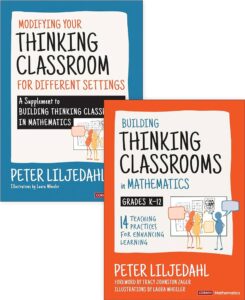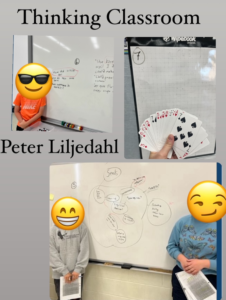
Major Project Update 3: Exploring Peter Liljedahl’s “Thinking Classrooms”
THINKING CLASSROOMS AND DIGITAL LITERACY
As many of my fellow classmates live in Regina, the name Peter Liljedahl or the concept of “Thinking Classrooms” might ring a few bells. Liljedahl frequently hosts PD in Regina (three of which I thoroughly enjoyed attending last year).
If I may make a shameless plug for my Division Curriculum committee, Light of Christ will be hosting Liljedahl for a four-day PD extravaganza in March 2024! Tickets will go on sale in the new year (be there, be there, be there).
Okay, shameless advertising over…
If you are unfamiliar with Thinking Classrooms, I highly recommend Liljedahl’s PD and books.

Thee Peter Liljedahl
 Essentially….
Essentially….
Thinking Classroom Key Aspects
- Vertical Non-permanent Surfaces (Wipebooks/Whiteboards):
- Writable surfaces to mind map, storyboard, and complete group work that encourages individuality, creativity, and expression.
- Random Groupings:
- Use playing cards (DIV I students: Groups of 2 / DIV II students: Groups of 3).
- Regularly change groupings to encourage collaboration in different contexts, mirroring real-world dynamics.
- One whiteboard marker per group – collaboratively shared.
- Gallery Walk/Debrief:
- Explore and discuss diverse ideas and methods of displaying thinking (in a safe, controlled setting).
- Fosters creativity, critical thinking, and reflection.
***Please note, this does not even touch on the summative assessment pieces of his work (which I also highly recommend).
And the point is…
In our last class, we discussed social media. Many of us (myself VERY MUCH included) felt unsafe – personally and on behalf of our students – exposing them to online risks for so-called school purposes. Since the start of the year, and more frequently in the last few weeks, I have been using my school’s Vertical Surface classroom to explore digital citizenship and social media aspects in a safe, controlled environment.
Using a combination of my own brainstorming, other online resource suggestions – particularly those from educational Instagram (it’s a wonderful niche community), and refining my ideas using ChatGPT, I have safely combined the Thinking Classroom key features with digital citizenship classroom outcomes….soooo, in my long-winded way, I thought I’d share!
Digital Citizenship Thinking Classroom
- Filter Bubbles:
- Students collaborate to map out and compare their own “filter bubbles” visually.
- Media Literacy Mind Mapping:
- Explore the methods and purpose behind messages in media (blatant and hidden), creating a better understanding of visuals, text, and tone.
- Groups deconstruct digital ads on Wipebooks, exploring persuasive techniques, target audience, and intended messages (awesome connection to ELA outcomes!).
- Digital Storyboarding Creation:
- Students plan and organize digital stories or assigned multimedia projects by collaboratively brainstorming together first – sketching scenes, dialogue, and transitions on Wipebooks.
- Media Literacy Timeline:
- Collaborative creation of a timeline on Wipebooks, showing key moments in media history and their societal impact (I have not done this with students yet but have had them collaborate on this topic using Canva).
- Digital Citizenship Pledge:
- Students craft personal digital citizenship pledges on Wipebooks, highlighting responsible and ethical online behaviour (I wish I had done this with students first thing this year; having them do it with families at home now).
- Fake News Identification Workshop:
- Using Wipebooks, students analyze real and fake news stories, improving their skills in differentiating between credible and unreliable sources (Doing this soon – based on my group project for class the other week).
- Interactive Digital Social Media Analysis:
- Exploration of user experiences and interactive elements in digital media on Wipebooks – how do “influencers influence”? What leads to greater online engagement? What is the cost (personal and financial)?
- Digital Diversity and Inequity:
- Students dissect online content to identify whose stories are amplified and whose voices are silenced (really excited about this one!).
Well then, this was meant to be a short post but I just wanted to share some of the ideas going into my final cross-curricular unit plan. Not everything will make it in, but I am excited to explore these ideas with students this year and in the years to come.

This look really awesome, Kim! I have heard of thinking classroom lots, but have honestly just never had the time to look into it or had anyone really explain it to me. I love the grouping idea you mentioned – having students work with a variety of people in the class is something I always think about and sometimes struggle with for a variety of reasons. I love the idea of having kids create digital citizenship pledges and I like it even more that they are now doing this with their families at home – a really great tie in to things we discussed in 832 this semester. I also really like the deep thinking analysis that you’re having the students do in relation to social media influencers because I don’t think kids think about the critical thinking questions you posed quite enough which is exactly how social media influencers gain popularity, unfortunately. I’m really excited to see your final product!
Thanks, Jacquie. I feel like I’ve bitten off a bit more than I can chew but it’s certainly been a learning experience tying everything together. When you have time, I definitely recommend reading Peter’s books or checking out his PD – some of the most worthwhile stuff I’ve learned about grouping, engagement, and student critical thinking.